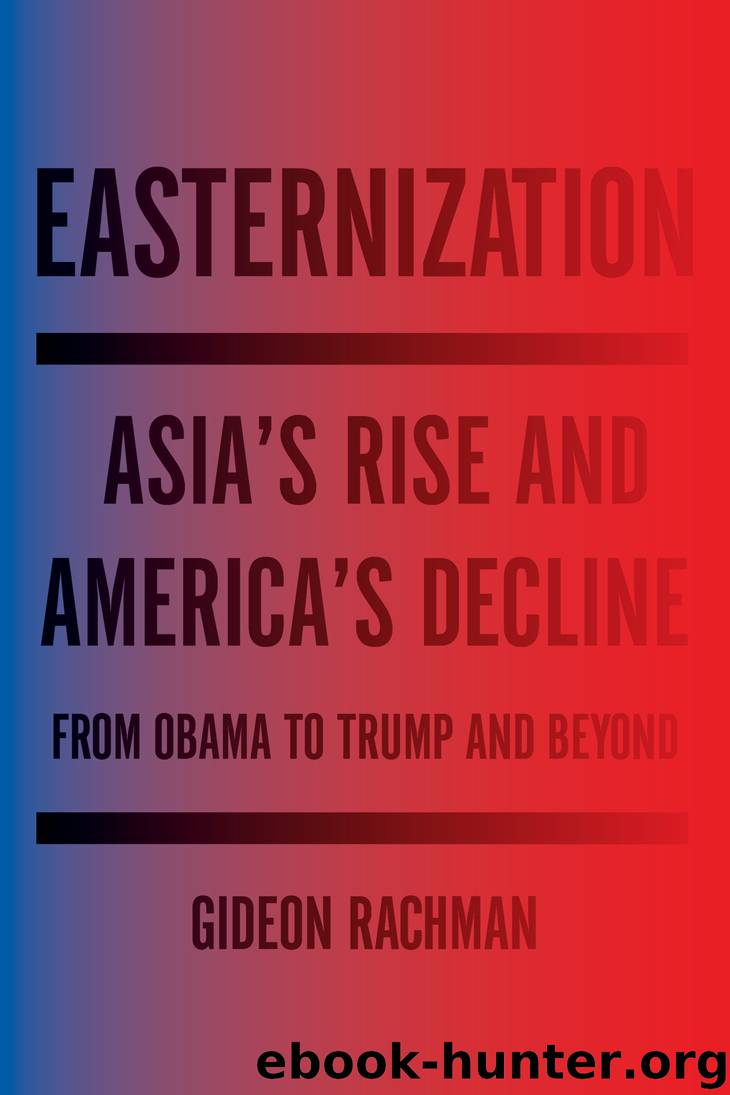Easternization by Gideon Rachman

Author:Gideon Rachman
Language: eng
Format: epub
Publisher: Penguin Random House LLC (Publisher Services)
Published: 2017-04-04T04:00:00+00:00
PART TWO:
EASTERNIZATION BEYOND ASIA
8.
THE QUESTION OF AMERICAN POWER
PERHAPS THE MOST FAMOUS image from Barack Obama’s period in office was the photo of the president and his team watching the raid on Osama bin Laden’s compound in Pakistan. The president is seated off to one side, hunched slightly and watching the screen intently. Hillary Clinton has her hand over her mouth, apparently gasping in shock at some unseen development. Tom Donilon, the national security adviser, stands at the back with his arms folded, looking impassive.
If you visit the room itself, you’ll note that it is even smaller than it appears in the official photo. (The famous image was taken with a fish-eye lens that exaggerated the size of the space that the president and his aides had crowded into.) On the day of the raid, the president’s national security team had assembled in the famous Situation Room in the basement of the West Wing of the White House, just down the corridor from the annex where military staff were monitoring the video feed of the raid. As the day unfolded, the key players had moved down the corridor to the annex, to watch the raid as it happened.
The killing of Osama bin Laden was a stark demonstration of the continuing reach, power, and ruthlessness of the United States. It stood President Obama in good stead when he ran for reelection in 2012. But if the president had hoped that the successful pursuit of the world’s most famous terrorist would come to define the Obama years, he was to be disappointed. Instead, as Obama’s eight years in office drew to a close, his presidency was being defined, both at home and abroad, as a period when American power was challenged all over the world—but especially in East Asia, Russia, and the Middle East.
The Chinese challenge to the Western-led world order—which was examined in the first part of this book—is part of a global phenomenon. In Europe, an angry and resurgent Russia slid into open confrontation with the West over the fate of Ukraine and Russia’s annexation of Crimea. As a result, the stability and peace of Europe and the power of the Western alliance was faced with its most severe challenge since the end of the Cold War.
In the Middle East, meanwhile, the state system that had been created by France and Britain in the aftermath of the First World War was crumbling under the impact of the revolutions and civil wars that were convulsing the Arab world. After the Second World War, the United States had emerged as the underwriter of the security order in the Middle East. As that order crumbled, many in the region and around the world pointed accusing fingers at the Obama White House. In June 2015, The Economist gave expression to a widespread complaint, when it lamented that “the Middle Eastern order sustained by the United States has collapsed…The Middle East desperately needs a new, invigorated engagement from America.”1
All of these regional crises came to be seen as connected by a general thread of American retreat from the world.
Download
This site does not store any files on its server. We only index and link to content provided by other sites. Please contact the content providers to delete copyright contents if any and email us, we'll remove relevant links or contents immediately.
The Meaning of the Library by unknow(2382)
Six Billion Shoppers by Porter Erisman(2223)
Why Nations Fail: The Origins of Power, Prosperity, and Poverty by Daron Acemoglu & James Robinson(2161)
No Time to Say Goodbye(1993)
Red Notice by Bill Browder(1923)
The Economist [T6, 22 Thg9 2017] by The Economist(1843)
Currency Trading For Dummies by Brian Dolan(1785)
Thank You for Being Late by Thomas L. Friedman(1675)
Bitcoin: The Ultimate Guide to the World of Bitcoin, Bitcoin Mining, Bitcoin Investing, Blockchain Technology, Cryptocurrency (2nd Edition) by Ikuya Takashima(1609)
Amazon FBA: Amazon FBA Blackbook: Everything You Need To Know to Start Your Amazon Business Empire (Amazon Empire, FBA Mastery) by John Fisher(1490)
Coffee: From Bean to Barista by Robert W. Thurston(1417)
The Future Is Asian by Parag Khanna(1396)
The Great Economists by Linda Yueh(1386)
Capitalism Without Capital: The Rise of the Intangible Economy by Jonathan Haskel(1336)
Pocket World in Figures 2018 by The Economist(1325)
How Money Got Free: Bitcoin and the Fight for the Future of Finance by Brian Patrick Eha(1320)
Grave New World by Stephen D. King(1312)
The Sex Business by Economist(1278)
Cultural Intelligence by David C. Thomas(1200)
